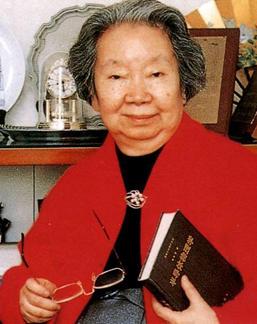Xie Xide facts for kids
Xie Xide (simplified Chinese: 谢希德; traditional Chinese: 謝希德; pinyin: Xiè Xīdé; 19 March 1921 – 4 March 2000) was a famous Chinese physicist. She was also known as Hsi-teh Hsieh or Hilda Hsieh. Xie Xide was the president of Fudan University from 1983 to 1989. After that, she continued to advise the university until she passed away. She helped create the university's Centre for American Studies. She also started its Modern Physics Institute in 1977.
Xie Xide was also a member of the Central Committee of the Chinese Communist Party. She served there from 1982 to 1992.
Who Was Xie Xide?
Xie Xide was born on March 19, 1921. Her birthplace was Quanzhou, a port city in southeastern China. Her family believed that education was very important.
Early Life and Education
A Family of Scholars
Xie Xide's father, Xie Yuming, had a PhD from the University of Chicago. He taught at Yenching University in Beijing. He was a brilliant scientist. The famous physicist, Yang Chen-Ning, even said that Xie Yuming was someone who deserved a Nobel Prize.
Xide spent some of her childhood in Beijing. She went to Yenching Elementary School. She was always a top student. There, she met Cao Tianqin, who also became a very good student. They became close friends.
Overcoming Challenges
When the Second Sino-Japanese War began, Xie went to Hunan University. She studied physics there. But she had to leave school because she got very sick. Doctors said her illness was not curable. She went home to get help from her family.
Her friend Cao Tianqin sent her many letters. These letters were about academic topics. They helped Xie feel better and keep studying. In 1942, Xie not only got better, but she also got into Xiamen University. She studied physics and mathematics there by studying on her own at home. She graduated in 1946.
Studying in America
After graduating, Xie taught at the University of Shanghai for a year. Then, she received a scholarship. This allowed her to study for a master's degree in physics. She went to Smith College in the United States. She finished her master's degree in 1949.
She continued her studies at Massachusetts Institute of Technology (MIT). In 1951, she earned a PhD in theoretical physics.
In 1950, many Chinese scholars were held in the United States. This was due to political tensions during the Korean War. Xie Xide was also held, even though she wanted to return to China. From 1951 to 1952, she worked as a researcher at MIT. In 1952, her friend Cao Tianqin helped her get released. They got married in the United Kingdom. Their son was born in 1956.
Returning to China and Fudan University
A Leader in Physics
After getting married, Xie returned to China. She became a lecturer in the Physics Department at Fudan University in Shanghai. Fudan is one of China's best universities. She worked as a lecturer from 1952 to 1956. Then she became an associate professor. From 1958 to 1966, she also helped lead the Shanghai Institute of Technical Physics. In 1962, she became a full Professor of Physics at Fudan University.
Xie Xide was an amazing educational leader. She also played a key role in connecting China's education with other countries. She co-wrote "Semiconductor Physics." This was one of the most used physics textbooks in China.
First Woman President
In 1958, she became very ill from overworking. She had to have several surgeries. But she still went back to teaching. During the Cultural Revolution in 1966, she was forced to do hard labor. She also got breast cancer. Despite all this, she never gave up her dedication to education.
In 1978, she returned to her work. From 1978 to 1983, she led the Institute of Modern Physics at Fudan University. She became vice president of Fudan in 1978. In 1983, she became the president. She was the first woman president of a major university in China. She served as president until 1988.
Building International Connections
As president, she started the Center for American Studies at Fudan. This center helped students learn about global research and international relations. She strongly encouraged her students to study abroad.
A Dedicated Scientist
Xie Xide had a very successful career as a scientist. She made important contributions to solid-state physics. This field studies how materials behave. Her research focused on semiconductors and surfaces of materials.
Xie Xide was chosen to be part of the Communist Party's Central Committee in 1982. She was one of 210 full members.
Her Legacy
Xie Xide's husband, Cao Tianqin, became very ill in 1987. He was paralyzed and lost his memory. Even though Xie was also sick, she took care of him. She planned his meals and helped him with physical therapy. She did this for 8 years until he passed away in 1995.
Xie continued her work even while fighting cancer. She passed away on March 4, 2000. She donated her body to medical research in China.
Important Books
Xie Xide wrote over eighty papers and several books.
Some of her important books include:
- Semiconductor Physics. Science Press, 1958, with K. Huang.
- Group Theory and Its Applications. China: Science Publisher, 1986.
Awards and Recognition
Xie Xide received honorary doctorates from twelve universities around the world. These included universities in the United States, United Kingdom, Japan, Canada, Hong Kong, and China.
She was also a Fellow of the American Physical Society. She was an Academician of The World Academy of Sciences (TWAS). She was also a Distinguished Scholar of the Committee on Scholarly Communication with The People's Republic of China.
See also
 In Spanish: Xie Xide para niños
In Spanish: Xie Xide para niños


